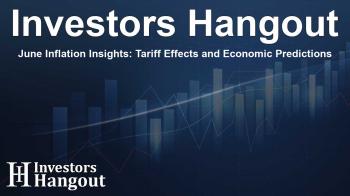June Inflation Insights: Tariff Effects and Economic Predictions

Subtle Signs of Tariff Impact on Inflation
The June core inflation figures unveiled a slightly lower-than-expected reading, leaving room for speculation about potential interest rate cuts from the Federal Reserve in upcoming meetings. However, economists warn that upcoming reports for July and August might not be as forgiving. The need for tangible evidence of weaker job figures remains critical for any timely Federal Reserve intervention.
0.228% - Month-over-Month core inflation - Less than anticipated.
Understanding Tariff Effects on Consumer Prices
The consumer price inflation report for June highlighted a 0.3% monthly increase in headline inflation, alongside a core inflation rise of 0.2%. This falls in line with market predictions. A closer examination reveals scattered signs of tariffs impacting specific goods, mainly in categories like fresh produce, household appliances, clothing, and toys. Despite this, significant offsets emerged from the crucial shelter component, which constitutes about 40% of the core CPI basket. The shelter index recorded an increase of only 0.2% month-over-month, while used vehicle prices dropped by 0.7%, a development that contrasts earlier inflation concerns. Additionally, airfare prices decreased by 0.1%, suggesting overall pressure easing in the consumer sector.
Political Rumblings Amid Economic Data
The core CPI figures falling short of expectations might provide politicians, particularly President Trump, with an opportunity to criticize the Federal Reserve's leadership. It's anticipated that tariffs will take time to fully influence market conditions, particularly in the reports slated for July through September. Trump has been vocally urging the Federal Reserve to make more drastic rate cuts, with hints from appointed officials suggesting support for immediate action. However, the prevailing sentiment among committee members remains cautious, especially in light of a stronger-than-expected jobs report from June.
Federal Reserve’s Cautious Approach
In light of past experiences, the Federal Reserve is wary of repeating previous mistakes, particularly regarding their initial characterization of supply shock inflation as temporary. With inflation touching 9% in 2022, Fed members are likely to take a more measured stance, ensuring that any price increases from tariffs are not perceived as a permanent condition. A substantial decline in job figures would be necessary to influence decisions at the forthcoming FOMC meeting in September.
Future Projections for Housing Market and Fed Action
Looking further ahead, the housing market may emerge as a significant contributor to disinflation trends by late 2025 and early 2026. Higher housing costs have historically strained consumer spending, but shifts in the market could reverse this trend. As unemployment potentially rises later this year due to increasing growth challenges, the Federal Reserve may find comfort in pursuing interest rate cuts. We expect an initial 50 basis point reduction in the upcoming December FOMC meeting as the economic landscape continues to evolve.
Frequently Asked Questions
What is the current state of US inflation?
The latest reports suggest a modest rise in inflation, with a core inflation reading of 0.228% month-over-month for June.
How have tariffs impacted consumer prices?
There is some evidence of tariffs influencing prices in various goods, but these effects have been largely mitigated by falling prices in key sectors, particularly housing and vehicles.
What actions might the Federal Reserve take in the near future?
The Fed may consider interest rate cuts if economic conditions worsen, notably if job numbers continue to decline.
Why is the housing market significant to inflation trends?
The housing market has been a major factor in driving inflation. Changes in this sector may influence disinflationary trends in the coming years.
How does the current inflation scenario affect consumers?
While inflation remains a concern for consumers, the recent data indicates a stabilizing environment that could lead to moderate price increases in key categories.
About The Author
Contact Owen Jenkins privately here. Or send an email with ATTN: Owen Jenkins as the subject to contact@investorshangout.com.
About Investors Hangout
Investors Hangout is a leading online stock forum for financial discussion and learning, offering a wide range of free tools and resources. It draws in traders of all levels, who exchange market knowledge, investigate trading tactics, and keep an eye on industry developments in real time. Featuring financial articles, stock message boards, quotes, charts, company profiles, and live news updates. Through cooperative learning and a wealth of informational resources, it helps users from novices creating their first portfolios to experts honing their techniques. Join Investors Hangout today: https://investorshangout.com/
The content of this article is based on factual, publicly available information and does not represent legal, financial, or investment advice. Investors Hangout does not offer financial advice, and the author is not a licensed financial advisor. Consult a qualified advisor before making any financial or investment decisions based on this article. This article should not be considered advice to purchase, sell, or hold any securities or other investments. If any of the material provided here is inaccurate, please contact us for corrections.

